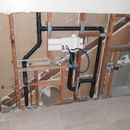Insulation of plumbing walls
I ‘m doing a major remodel to a 1975 house. As usual, I only cut holes in the sheetrock where I needed them but as the project went on I ended up with several large (8′ by 8’) and many smaller holes. Eventually I wished I had removed a lot more sheetrock at the beginning. Be that as it may, now I have to insulate all those areas. The existing insulation is foil-faced R-11 poorly installed and the rim joists have no insulation at all.
What are my options to insulate the areas I hav access to? Some of them have so much plumbing and electric that it is almost impossible to insulate around them but the foam or cellulos may be too expensive in a limited area. What do you think?
I have attached a picture of one of the worst walls.
Thanks
Steve
GBA Detail Library
A collection of one thousand construction details organized by climate and house part










Replies
Stephen,
So, you have a washing-machine hookup on an exterior wall? That's not a good idea.
Where do you live? It's hard to give advice if we don't know your climate.
In a cold climate, it's a safe bet that the pipes shown in the photo would freeze, unless you have a thick layer of rigid foam on the exterior side of your wall sheathing.
If you live in a mild climate -- Climate Zone 4 or warmer -- the building codes require only R-13 insulation. That's about 2 inches of closed-cell spray foam. Assuming that you have 2 inches between your plumbing pipes and your wall sheathing, that would probably be your best approach here. At least with spray foam, you prevent the type of air leakage that is the usual cause of frozen pipes.
If you are doing the work yourself, you can buy a two-component spray foam kit at most lumberyards.
If you were starting this project from scratch, there would have been lots of ways to do it better. Ideally, you wouldn't have routed any plumbing pipes in the existing exterior stud bays. If I were doing this work, I might have filled the existing stud bays with any old insulation -- even high-density fiberglass batts -- and then installed a continuous layer of rigid foam, preferably foil-faced polyiso at least 2 inches thick. Then you could have built another 2x4 wall on the interior side of the polyiso for your plumbing.
there are places online that sell the 2 part foam pretty reasonably, betterfoam used to be cheap,
sheetrock is like 9 bucks a sheet, it is as easy to detail a full sheet as it is a hole.......
The laundry wall is just one of many. Most of the plumbing in this house in on exterior walls although freezing is not an issue in Climate zone 3 just one mile from the ocean in Santa Cruz, California. I looked at the betterfoam site and that shows promise but I have heard many bad things about the amount of Greenhouse gas these kits release.
As to the cost of sheetrock, I do this on nearly every remodel I do. I start off trying to do as little damage and create as little waste as possible, and in the end wished I had removed all the sheetrock at the beginning. It would save time and probably money. I never learn!
How about cellulose? Would that work in this situation?
Stephen,
There are two issues here: the issue of code compliance and the issue of good practice.
When it comes to code compliance, you should check with your local building official. These issues are subject to interpretation.
When it comes to good practice, all of your wall insulation should be on the exterior side of your plumbing pipes. Since I don't know how many inches you have between your plumbing pipes and your wall sheathing, it's hard to make a recommendation. However, whenever space is tight, it's hard to beat closed-cell spray foam.